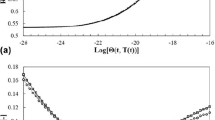Possible ways are considered for increasing oxide powder energy with regard to intensifying sintering (activation). This is achieved in four cases. First, with an increase in temperature, i.e., supply of thermal energy from outside. Second, with an increase in internal energy with mechanical grinding of particles due to an increase in surface energy and defects. Third, with an increase in internal energy during chemical methods for powder preparation under essentially nonequilibrium conditions due to an increase in surface energy, and surface and volume defect energy. Fourth, with an increase in internal energy on introducing additives as a result of lattice deformation energy with extraneous ion introduction, and also lattice defect energy on introducing heterovalent ions.
Similar content being viewed by others
References
K. V. Mikhailov (editor), Building Industry and Industrial Structural Materials: Encyclopaedia [in Russian], Stroizdat. Moscow (1996).
V. S. Bakunov, A. V. Belyakov, E. S. Lukin, and U. Sh. Shayakhmetov, Oxide Ceramics. Sintering and Creep: Textbook (V. S. Bakunov, editor) [in Russian], RKhTU im D. I. Mendeleeva, Moscow (2007).
A. M. Prokhorov (editor), Soviet Encyclopaedic Dictionary, 3rd. ed. [in Russian], Sov. Entsiklopediya, Moscow (1985).
P. V. Kovtunenko, Solid Physical Chemistry. Crystals with Defects [in Russian], Vysshaya Shkola, Moscow (1993).
Ya. E. Geguzin, Physics of Sintering [in Russian], Nauka, Moscow (1985).
V. S. Bakunov and A. V. Belyakov,”Ceramic technology as a process of energy accumulation and dissipation,” in: Composite Material Structures [in Russian], Izd. FGUP VIMI, Moscow (2005).
V. S. Bakunov, A. S. Vlasov, I. Ya. Guzman, et al., Ceramics of Highly Refractory Oxides [in Russian], Metallutgiya, Moscow (1977).
V. S. Bakunov, “High-temperature creep of refractory ceramics. Features of the process,” Ogneupory, No. 12, 4 – 7 (1994).
N. T. Adrianov, V. L. Balkevich, A. V. Belyakov, et al., Ceramic Chemical Technology: Texbook (I. Ya. Guzman, editor) [in Russian] OOO RIF Stroimaterialy, Moscow (2003).
V. A. Ivensen, Sintering Phenomenology [in Russian], Metallurgiya, Moscow (1985).
G. S. Khodakov, Grinding Physics [in Russian], Nauka, Moscow (1972).
I. A. Khint, “Main problems of mechanical activation,” Proc. 5th Symp. on Solid Mechanoemission and Mechanochemistry, Tallin (1975).
A. V. Belyakov, “Chemical synthesis of ceramic materials from the position of synergetics,” Khim. Prom., No. 2, 81 – 91 (1997).
E. S. Lukin, “Contemporary highly dense oxide ceramics. Part 1,” Ogeneupory Tekhn. Keram., No. 1, 7 – 14 (1996); No. 2, 9 – 18 (1996).
E. Feder, Fractals [in Russian], Mir, Moscow (1991).
V. D. Jones, Bases of Powder Metallurgy. Pressing and Sintering [Russian translation], Mir, Moscow (1965).
V. N. Chebotin, Solid Physical Chemistry [in Russian], Khimiya. Moscow (1982).
B. B. Kadomtsev, Dynamics and Information [in Russian] Ed. Zh. Uspekhi Fiz. Khim., Moscow (1997).
E. S. Lukin, “Contemporary highly dense oxide ceramics. Part II,” Ogeneupory Tekhn. Keram., No. 4, 2 – 13 (1996); No. 5, 2 – 9 (1996).
E. S. Lukin, “Contemporary highly dense oxide ceramics. Part III,” Ogeneupory Tekhn. Keram., No. 1, 2 – 5 (1997); No. 3, 2 – 9 (1997).
Author information
Authors and Affiliations
Corresponding author
Additional information
Translated from Novye Ogneupory, No. 6, pp. 32 – 36, June 2015.
Rights and permissions
About this article
Cite this article
Bakunov, V.S., Lukin, E.S. Intensification of Polycrystalline Oxide Ceramic Sintering. Refract Ind Ceram 56, 281–285 (2015). https://doi.org/10.1007/s11148-015-9831-3
Received:
Published:
Issue Date:
DOI: https://doi.org/10.1007/s11148-015-9831-3




